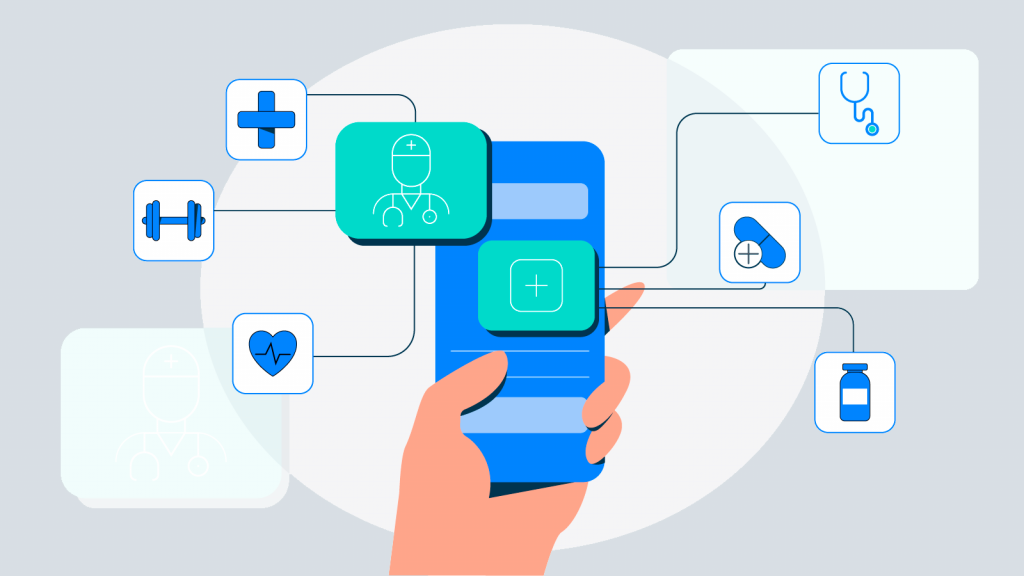
How To Build a Telehealth App: Everything you Need to Know

Are you wondering how to build a telemedicine or telehealth app with video calls, medical information, and maybe photo-based consultations for your business, or simply want to know more about telehealth apps? The following will give you the answer to all of your questions about telehealth app development.
Table Of Contents
ToggleWhat is Telehealth App?

Telehealth describes the use of electronic communications and information technologies, such as videoconferencing, phone calls, and messaging, to provide healthcare services remotely. A telehealth app is a type of software application that enables healthcare providers to deliver care to patients remotely, using these electronic communication technologies.
Telehealth apps can be used to provide a range of healthcare services, including consultations with physicians, mental health counseling, and remote monitoring of patient’s health. They can be particularly useful when it is difficult for patients to physically visit a healthcare facility, such as in rural areas or during the COVID-19 pandemic. Also, telehealth apps can reduce the burden on healthcare systems by allowing providers to see more patients in a given day and by helping to reduce the number of in-person visits to healthcare facilities.
How To Build a Telehealth App?

Building a telehealth app can be a complex process, as it involves the integration of various features and technologies to enable remote healthcare services. So, when it comes to how to build a telehealth app, here are the steps you should follow:
#1 Evaluate your Ideas

To build a telehealth app that meets your demand, your team needs to be well-informed. Evaluating your idea correctly can help you understand app functionality and market conditions. To confirm that your idea is viable, you must be able to answer why you want to develop a healthcare app and why you specifically to be a telehealth app. Here are some steps for evaluating your idea.
- Conduct business analysis
- Research the market and your competitors
- Define a unique value proposition
- Create a prototype, conduct testing, and get feedback
- Research marketing channels
#2 Business Analysis

The business analysis allows you to determine the demand for your app and define your buyer persona, which will define your target audience. The analysis helps you to promote your app effectively after launch by understanding who your customer is.
#3 Market and Competitor Research
As you move into the telehealth software development stage, you’ll begin to research your potential competitors. Researching their strengths and weaknesses, ratings, and user reviews will help you understand how well your app can compete with theirs. When researching market leaders, pay attention to their prices, platforms, and differences between their apps and your idea.
#4 Unique Value Proposition

When developing a telehealth app consider these unique features:
- High-quality communication features. To make a telehealth app work, it needs to have efficient communication features. An application for communicating with people should include a quality tool for communication. Seamless chat functionality will help doctors work with patients efficiently and make the user experience seamless; quality video conferencing features will ensure that the information parties receive is what it is intended to be — you don’t want your doctors to misdiagnose someone because they didn’t see or hear the patient clearly.
- Doctor and patient information. People always want to know more about the doctors they’re consulting with, so telehealth apps can provide information about qualifications, rates, number of previous patients, and patient reviews. Doctors can see a patient’s electronic health record to understand their problems quickly.
#5 Prototyping

There are several different prototypes of the telehealth app development process. All of them are necessary to ensure that everything in the app works as it should. For example, a navigation concept is a sketch of the functionality created to ensure mutual understanding between the client and the developers. Then gradually, UI/UX designers add more and more details to this new prototype until it becomes a fully fleshed-out app.
#6 Testing and Getting Feedback

Testing is vital for app development, especially in markets with high competition like telehealth apps. You need to test everything from the design, features, to monetization before launching your app for the users to access.
Testing is usually performed first by quality assurance engineers and then by a test group of users. After each test, the developers analyze the feedback, make changes and improvements, and fix bugs.
#7 MVP Development
A minimum viable product (MVP) is a version of your telehealth app that has bare-bones functionality but is enough for a limited launch. It usually has the absolutely necessary features and a unique value proposition, with barely any UI design. At Mind Studios, we usually opt for an MLP — minimum lovable product — where apps also have refined design and quality user experience. This is important if you want to retain users.
#8 Research Marketing Channels
The telehealth app post-launch phase is also very crucial. How can you get your audience interested in using your app beyond advertising it at your healthcare facility? You should be aware of the social media platforms your target market uses, the information they look for online, the days of the week they like to use their smartphones, and many more. In order to maximize your profits, advertise your app on platforms with a high concentration of your target audience.
#9 Know the Law
The American Telemedicine Association reports that telehealth development is transforming the healthcare industry. The law that was passed in 2015, the Medicare Access and CHIP Reauthorization Act of 2015 (MACRA), opens up possibilities to develop, improve, update, and expand telemedicine apps and implement this technology in clinical organizations and societies, patient advocacy organizations, educational institutions, and independent research organizations.
So, before you launch your telehealth app or telemedicine app, you need to thoroughly research the legislation in your country specifically on the topic of telehealth regulations. This way, you’ll avoid a lot of possible clashes with the government.
Types of Telehealth in Healthcare
Telehealth can be used to improve access to healthcare and improve patient outcomes. It can also be used to reduce healthcare costs and improve the efficiency of the healthcare system. Here are several types of telemedicine that can be used in healthcare software development:
- Live video consultations: These are video chats that take place in real time between a patient and a healthcare professional. They may be carried out using a tablet, smartphone, or computer equipped with a camera and an internet connection.
- Store-and-forward telehealth: This type of telehealth involves the transmission of medical images, such as X-rays or CT scans, and other medical data between healthcare providers and patients. This can be done through a secure electronic medical record system or through a secure messaging platform.
- Remote patient monitoring: This is the process of remotely gathering and sending patient data, such as vital signs, to a healthcare physician using sensors and other equipment. This can be used to keep tabs on the well-being of individuals with long-term diseases or to assess how well people are healing following surgery.
- Mobile health (mHealth): mHealth refers to the delivery of healthcare services using portable electronic devices like smartphones and tablets. Appointment scheduling, prescription reminders, and virtual consultations are examples of mHealth
- Teletherapy: This refers to the provision of mental health services, including therapy and counseling, using video calls or other forms of technology in telecommunication.
Telehealth App Development – Success Story

The client is from a pharmaceutical company in Japan. After the COVID-19 outbreak, they faced the need to provide patients with a distance communication solution while enabling medicine data and streamlining medicine purchases.
After working with us, our client is provided with a telehealth app with advanced features. The app benefits both medical professionals and patients. The users can browse information like ingredients or side effects of more than 12.500 types of OTC drugs and 22.000 types of prescription drugs by using drug names, barcodes, or QR codes.
>> Read more about our Telehealth App Showcase
Final Thought
Building a telehealth app requires careful planning and consideration of a variety of factors when hiring telemedicine app developers and choosing telemedicine app development companies. As a top 10 software development company in Vietnam, Newwave Solutions is always ready to take your healthcare software development project to the next level.
Contact our team of experienced developers now to know more about how to build a telemedicine app and see how we can help bring your project to life!
To Quang Duy is the CEO of Newwave Solutions, a leading Vietnamese software company. He is recognized as a standout technology consultant. Connect with him on LinkedIn and Twitter.
Related News
-
 Unlocking the Benefits of IT Outsourcing: A Comprehensive GuideDecember 4, 2024 View more
Unlocking the Benefits of IT Outsourcing: A Comprehensive GuideDecember 4, 2024 View more -
 5 Advantages of IT Outsourcing Every Business Should KnowNovember 29, 2024 View more
5 Advantages of IT Outsourcing Every Business Should KnowNovember 29, 2024 View more -
 Essential Insights Into Software Development OutsourcingNovember 21, 2024 View more
Essential Insights Into Software Development OutsourcingNovember 21, 2024 View more



